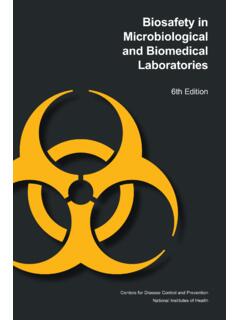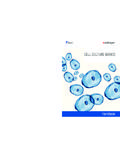Transcription of Laboratory Procedure Manual - Centers for Disease Control ...
1 Laboratory Procedure Manual Analyte: Complete Blood Count Matrix: Whole Blood Method: Complete Blood Count with 5-Part Differential Method No.: Revised: as performed by: Contact: November 2007 Important Information for Users CDC periodically refines these Laboratory methods.
2 It is the responsibility of the user to contact the person listed on the title page of each write-up before using the analytical method to find out whether any changes have been made and what revisions, if any, have been incorporated. Complete Blood Count (CBC) with Five-Part Differential NHANES 2005 2006 Public Release Data Set Information This document details the Lab Protocol for testing the items listed in the following table: Lab Number Analyte SAS Label LBXWBCSI White blood cell count (SI) LBXLYPCT Lymphocyte (%) LBXMOPCTM onocyte (%) LBXNEPCT Segmented neutrophils (%) LBXEOPCT Eosinophils (%) LBXBAPCT Basophils (%) LBDLYMNOL ymphocyte number LBDMONO Monocyte number LBDNENO Segmented neutrophils number LBDEONO Eosinophils number LBDBANO Basophils number LBXRBCSI Red cell count SI LBXHGB Hemoglobin (g/dL)
3 LBXHCT Hematocrit (%) LBXMCVSI Mean cell volume (fL) LBXMCHSI Mean cell hemoglobin (pg) LBXMC MCHC (g/dL) LBXRDW Red cell distribution width (%) LBXPLTSI Platelet count (%) SI CBC_d LBXMPSI Mean platelet volume (fL) Page 2 of 32 Complete Blood Count (CBC) with Five-Part Differential NHANES 2005 2006 1. Clinical Relevance and Summary of Test Principle Perform a complete blood count (CBC) in duplicate on all Sample Persons (SPs) age 1 and older. Perform the CBC on the Beckman Coulter MAXM. Run a CBC on home exam SP s EDTA blood tubes after returning to the MEC. A. Purpose and Principle of Test The Beckman Coulter method of sizing and counting particles uses measurable changes in electrical resistance produced by nonconductive particles suspended in an electrolyte.
4 A suspension of blood cells passes through a small orifice simultaneously with an electric current. A small opening (aperture) between electrodes is the sensing zone through which suspended particles pass. In the sensing zone, each particle displaces its volume of electrolyte. Beckman Coulter measures the displaced volume as a voltage pulse, the height of each pulse being proportional to the volume of the particle. The quantity of suspension drawn through the aperture is for an exact reproducible volume. Beckman Coulter counts and sizes individual particles at a rate of several thousand per second. This method is independent of particle shape, color, and density.
5 The MAXM is a quantitative, automated, differential cell counter for in vitro diagnostic use. The MAXM measures these parameters in whole blood: Cell Parameter Measured Pulse size wavelength calculation Reported units WBC white blood cell count WBC bath 35 fL n 103 cells/ L RBC red blood cell count RBC bath 36 360 fL n 106 cells/ L Hgb hemoglobin concentration WBC bath 525 nm g/dL Hct hematocrit computed RBC x MCV/10 % MCV mean cell volume derived from RBC histogram # size of RBC/total RBC fL MCH mean cell hemoglobin computer Hgb/RBC 10 pg MCHC mean cell hemoglobin concentration computed Hgb/Hct 100 g/dL RDW red cell distribution width derived from RBC histogram CV expressed in % of the RBC size distribution % Plt platelet count RBC
6 Bath 2 to 20 fL n 103 cells/ L MPV mean platelet volume derived from Plt histogram Mean volume of Plt population under the fitted curve constant fL NE% neutrophil percent derived from scatterplot # cells inside NE area/# cells inside total cell area 100 % NE # neutrophil number absolute numberNE%/100 WBC count 103 cells/ L Page 3 of 32 Complete Blood Count (CBC) with Five-Part Differential NHANES 2005 2006 LY% lymphocyte percent derived from scatterplot # cells inside LY area/# cells inside total cell area 100 % LY# lymphocyte number absolute numberLy%/100 WBC count 103 cells/ L MO% monocyte percent derived from scatterplot # cells inside MO area/# cells inside total cell area 100 % MO# monocyte number absolute numberMO%/100 WBC count 103 cells/ L EO% eosinophil percent derived from scatterplot # cells inside EO area/# cells inside total cell area 100 %
7 EO# eosinophil number absolute numberEO%/100 WBC count 103 cells/ L BA% basophil percent derived from scatterplot # cells inside BA area/# cells inside total cell area 100 % BA# basophil number absolute numberBA%/100 WBC count 103 cells/ L *PDW platelet distribution width and percent platelet crit are NOT for diagnostic use and do not print. Coulter uses the value for PDW as an internal check on the reported platelet parameters, Pct and MPV. Methodology: The methods used to derive CBC parameters are based on the Beckman Coulter method of counting and sizing, in combination with an automatic diluting and mixing device for sample processing, and a single beam photometer for hemoglobinometry.
8 The WBC differential uses VCS technology. Analysis and classification of WBCs use three simultaneous measurements of individual cell volume (V), high frequency conductivity (C), and laser light scatter (S). The scattergram plots the cells based upon the measurements of these three parameters. 2. Special Safety Precautions All specimens may be potentially positive for infectious agents including HIV and the Hepatitis B and C virus. Observe universal precautions. It is mandatory to wear gloves and lab coat when handling all human blood products and Beckman Coulter controls. Wear safety glasses whenever operating the instrument in SECONDARY mode.
9 Dispose of all biological samples in a biohazard container and wipe down all work surfaces with 1% bleach solution at the end of each session. The Mobile Examination Center (MEC) Hazardous Chemicals Manual contains all Coulter Material Safety Data Sheets (MSDS). 3. Computerization: Integrated Survey and Information System (ISIS) The MAXM Data Management System (DMS) transmits individual SP results to the MEC automated ISIS system. Review all SP results at the Coulter DMS monitor. The hematology module in the Laboratory application automatically receives the results or transmits them manually to the hematology module. The Laboratory application evaluates the data for completeness and accuracy.
10 The final decision to accept or reject a result is the responsibility of the medical technologist. Page 4 of 32 Complete Blood Count (CBC) with Five-Part Differential NHANES 2005 2006 All data are backed up and stored at Westat's home office. 4. Procedures for Collecting, Storing, and Handling Specimens; Criteria for Specimen Rejection A. Specimen collection The phlebotomist collects a 3- or 5-mL K3 EDTA tube on all SPs aged 1 year and older following established venipuncture protocol and procedures (a 1-2% dilution effect occurs in this liquid EDTA tube). B. Specimen preparation Run the CBC as soon as possible; there is no requirement to wait any length of time between drawing the blood and running the CBC.













